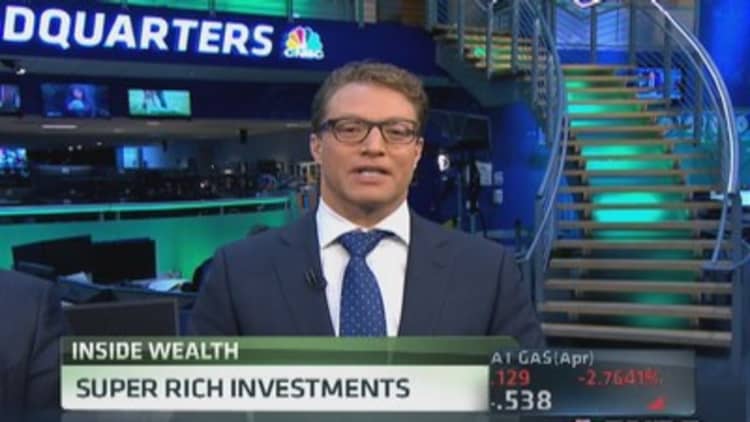
Many Americans heading toward retirement are hoping to exit the workforce on time instead of working longer just to play retirement savings catch-up.
The problem is, a majority of pre-retirees are not so confident that they will be able to pull it off, say industry experts.
There is a viable option, however. Whether it's an art collection, a rare baseball card or a variety of other collectibles, selling them now may be a way to increase your retirement savings, according to some experts.
The Employee Benefit Research Institute's 2014 Retirement Confidence Survey found that only 18 percent of workers are confident they will have enough dollars to comfortably retire; nearly a quarter said they are not at all confident.
Last year 401(k) balances hit record highs, with the average balance for those on the verge of retirement—ages 55 to 64—rising to $165,200, according to Fidelity. Even with rising markets giving a boost to portfolios, the numbers still don't add up to a dreamy future.
Of even more concern: Fidelity found that 35 percent of its participants had cashed out their 401(k)s after exiting their job—setting savers back even further.
In the last year, markets have continued to rise and real estate has been scoring big gains—up 11.3 percent last year, according to Case-Shiller Home Price Indices.
This means pre-retirees are likely to see their accounts growing, and some might be considering selling their homes while things are looking up.
The problem is that, at any point in time, we could find ourselves in a burst bubble—all part of the uncertainty of the markets. No one knows if or when it will happen, but some believe they are seeing signs.
David Einhorn's hedge fund, Greenlight Capital, recently issued a letter to its investors stating that "there is a clear consensus that we are witnessing our second tech bubble in 15 years."
The letter went on to express the uncertainty of how much bigger the bubble can grow before bursting.
When it comes to real estate, Nobel Prize–winning economist Robert Shiller has been warningthat data is showing a possible slowdown in housing.
This year the rise in home prices is not expected to hit double digits, as it did in 2013. Clear Capital, a research firm that serves the mortgage and lending industry, projects 2014 home prices to rise by no more than 5 percent.
Read MoreWhy you need to save for retirement now
While markets and real estate are flying high at the moment, now could be the time to also consider selling off some of your alternative assets, such as those collectibles you have been holding on to for years.
There are several markets on the rise at the moment, having bounced back from lulls during the recession.
Selling now could prove to be a good way to catch up on retirement savings, whether by putting the cash in a safe place or by adding it to your portfolio.
Art
The art market is on fire, and record-high sale prices are being shattered all the time. Late last year, Francis Bacon's "Three Studies of Lucian Freud" (whose works are also skyrocketing) sold for $142.4 million, making it the most expensive work of art ever sold. Right now the big money is in contemporary, modern and Impressionist art, as well as anything by the "great masters."
Historically, art follows a seven-year cycle, sometimes taking a dip because of the economy and sometimes due to big players bowing out, as the Japanese did in the late 1980s and early '90s. However, the art world is starting to see one fundamental change.
According to Philip Hoffman, CEO of The Fine Art Fund Group—the largest art investment and advisory firm in the world—the market is beginning to shift as people buy works as an investment in order to diversify portfolios.
Access is also transforming the space and driving the surge in prices. Heidi Zuckerman Jacobson, director of the Aspen Art Museum and incoming chair of the Young Presidents' Organization (YPO) Art Network, says that due to the broad expansion of art fairs, galleries and artists, buyers and sellers have multiple points of access to works like never before, creating the globalization of the art world.
YPO is a global network made up of more than 20,000 chief executives. (Disclosure: CNBC has an exclusive editorial partnership with the organization.) Jacobson sees YPO members taking a growing interest, with the group's art network growing to more than 1,000 members—a glimpse into the global interest among chief executives.
While only the 1 percent have the ability to buy and sell these high-priced works for a profit, the high-end market is giving the lower end a boost. Owners can see works they purchased for $20,000 selling for $100,000.
The problem is getting in and out at the right time.
"Works by young artists is a very volatile market; there is a lot of high risk," warned Hoffman.
Those who have been holding certain works are now in a bit of a conundrum. Art from the 19th century is falling due to a lack in popularity, and "brown furniture" works from the late 19th and early 20th centuries have plummeted over the last 20 years.
Brown furniture is an industry term referring to heavy dining, bedroom and other sets crafted of dark woods such as walnut. "If you bought a piece of brown furniture for $200,000 in the last 20 years, the value could have dropped to $40,000 or $50,000," Hoffman said.
The dilemma for owners of works such as brown furniture is that values will eventually go back up—but not for another 30 to 50 years, said Hoffman. That means those who are older have to decide to either cut their losses and sell for the extra cash in retirement or hold in the hopes that prices will rise and, at the very least, will it to their heirs.
Owning works of art sounds like it is out of reach for everyone except the megawealthy. However, some individuals have had amazing success when it comes to selling off works they have owned for decades. Perhaps the most famous example is the collection of Victor and Sally Ganz.
The couple owned and operated a small costume-jewelry business and, starting in the 1940s, began purchasing art for the love of it, mostly "on the cheap," for just a few thousand dollars per piece. The bulk of the Ganz's collection was sold off in 1997 after their deaths—netting their heirs $183.8 million at a single auction.
The return on their investment is astounding. A study by William Landes, professor emeritus of law and economics at the University of Chicago Law School, found that if the Ganzes had invested $7,000—the same price they paid for a famous Picasso—in large-company stocks back in 1941, their investment would have been worth $7.9 million by 1997.
By contrast, the Picasso in question sold for $48.4 million the same year. Interestingly, if they'd invested solely in small-company stocks, they would have had a portfolio worth $47.8 million—close to the painting's selling price.
For those considering investing, there is an element of "buyer beware," as art can be a risky asset class that, in the long run, might not get the best of returns.
A recent international academic study (by scholars from Emory and Stanford universities in the U.S. and Erasmus and Luxembourg universities in the EU) found that the value of fine art tends to be overvalued and that the actual average annual return of art is around 6.5 percent. The study looked at more than 20,000 paintings that were repeatedly sold from 1972 to 2010.
This means that investors could potentially get a better return by putting their money elsewhere. For example, Vanguard looked at data starting in 1926 and found that portfolios with a traditional 60 percent stock, 40 percent bond split has an average annual return of 8.6 percent.
Sports memorabilia
While fine art has often been out of many average investors' budgets, sports memorabilia is more likely to have been accessible at some point to those now on the verge of retirement. Like art, the sports collectible market is rising, with items selling at all-time highs. Far and away, baseball-related items lead the market.
According to Ken Goldin—founder of Goldin Auctions, a leading house for sports collectibles—"hero memorabilia," such as jerseys and bats used by icons such as Mickey Mantle, are hot right now. "Pre-1970 used paraphernalia is what is moving, as well as modern world championship rings, which are skyrocketing in prices," he said.
It's not just the iconic players whose collectibles are worth a mint. When New York Yankee Derek Jeter announced his retirement earlier this year, some memorabilia related to him "doubled on the spot," according to Goldin.
To illustrate just how hot the market is, Goldin cited an unspecified item that will soon be up for auction. It was purchased 17 years ago by his client for $50,000; Goldin expects it to now sell for $1 million.
When it comes to baseball cards, the market is relatively flat, but there are certain standouts that are highly sought after. A classic example of a skyrocketing baseball card is Mickey Mantle's 1952 Topps rookie card. If purchased 30 years ago, it would have cost around $5,000; today it would sell for about $1.5 million.
Read MoreNow could be the time for baby boomers to sell
The stock market is responsible, in part, for today's sports collectibles mania. When collectors have more discretionary income, thanks to rising portfolios, the sports collectibles market starts to rise, too.
For those individuals who bought in 2008, now might be the time to start auctioning off purchases. In the year of the Great Recession, Goldin had a "very good selling season," the reason being many people wanted to put money into something concrete after being scared away from the markets.
Goldin is starting to see an uptick in product turnover, specifically among older individuals. "People who are in their 70s and bought 30 years ago are now looking to sell as they start their estate planning," he said.
For those holding such items, they're in luck when it comes to finding prospective buyers. Unlike art, which has a handful of true high-end buyers, sports memorabilia casts a much wider net, with young and wealthy entrepreneurs, celebrities and Silicon Valley start-up founders looking to buy.
Those holding celebrity, movie and music collectibles are not likely to see the same gains as a sports collector. Goldin said the reason for this is that, unlike movies and celebrities, which tend to fall out of fashion, sports collectibles resonate with all generations.
Antiques market
The wider collectibles market is mixed in value. The prices of collectibles such as commemorative plates and Hummel and Precious Moments figurines have taken such a tumble in recent years that they are relatively worthless, often selling for $1 or $2 apiece.
"The limited-edition craze of the 1970s is essentially dead," said Terry Kovel, co-founder of Kovels Antiques, a leader in the antiques and collectibles market.
The drop in popularity of these once-hot collectibles is due, in part, to generational differences. According to Kovel, "This generation buys select few items, sells them and then buys up, [where] my generation would buy the entire collection." She says one reason for this is that millennials tend to change jobs and move more often, leaving them with little room for vast collections. Also, having a wallful of Hummels or plates is just not in vogue.
Not all is lost in the antique collectibles world, as there are several markets rising, and pre-retirees are likely to be holding some of these valuables. Antique advertising, such as original Coca-Cola signs, are in great demand, as are antique bottles. Kovel said that the latter are starting a new 25-year cycle of going up in value.
Guns is another market where prices are hitting highs. Fear over the possibility of future government regulation has whipped gun collectors into a buying frenzy. James D. Julia, a top firearms auctioneer, set a world record in March when it auctioned off more than $19 million in guns.




